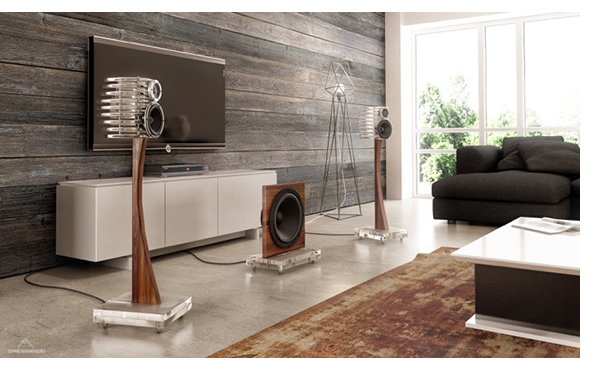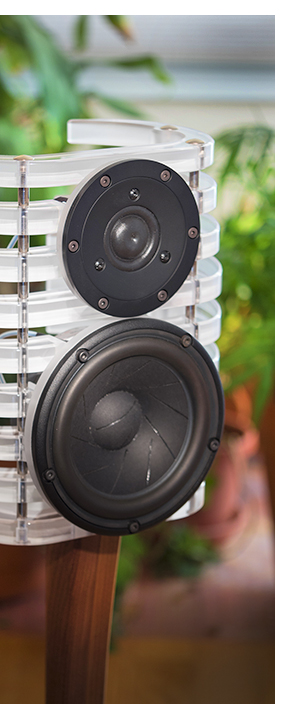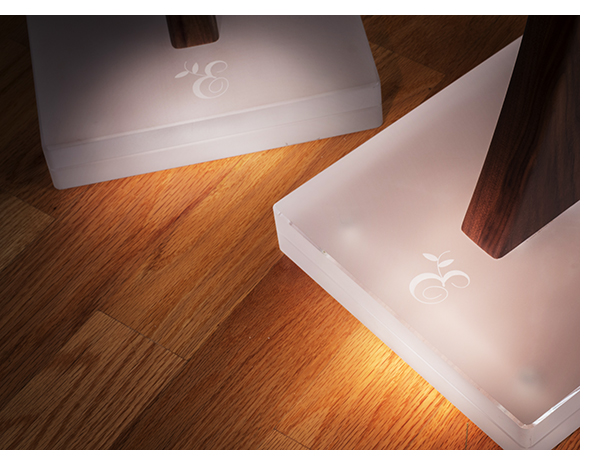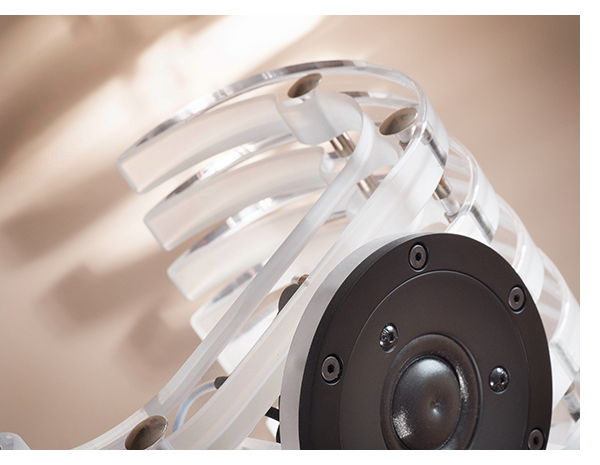The Eden Acoustics Tomei System An all-inclusive audio concept
By Jeff Dorgay New experiences and overcoming past prejudices are always one of the most fun parts of my job evaluating hifi components. While I’ve never been a fan of open baffle speakers in the past, Eden Acoustics importer Larry Borden has convinced me that the Tomei system is not only compelling but exceptional in every way.
New experiences and overcoming past prejudices are always one of the most fun parts of my job evaluating hifi components. While I’ve never been a fan of open baffle speakers in the past, Eden Acoustics importer Larry Borden has convinced me that the Tomei system is not only compelling but exceptional in every way.
Taking into account that he and I both share an equal enthusiasm for electrostatic speakers, along with the unique German Physiks speakers (which he also imports), I can see why he is so enthusiastic about this product. He’s quick to point out that this is “the perfect music system for the enthusiast wanting to exit the upgrade treadmill.”
Dealers often generate a fair share of margin from selling ancillary items, such as cables. While many audiophiles love agonizing over component choices as much as a good sommelier does over pairing the right wine with a meal, it’s up to you to decide if the Tomei system delivers you from the agony of endless choices, or deprives you of the same. As a music lover foremost, I’ll take the former.
 Eden goes a step further in their approach, claiming their speakers are of a baffle-less design. The artfully designed shape of the Tomei is so small, thanks to the Lucite cutouts, there is no baffle to speak of. It’s almost as if the 6-inch (150mm) woofer and 1-inch (29mm) soft dome tweeter float in mid air. This intriguing design begs to have spotlights blast through them to cast interesting shadows on your listening room walls.
Eden goes a step further in their approach, claiming their speakers are of a baffle-less design. The artfully designed shape of the Tomei is so small, thanks to the Lucite cutouts, there is no baffle to speak of. It’s almost as if the 6-inch (150mm) woofer and 1-inch (29mm) soft dome tweeter float in mid air. This intriguing design begs to have spotlights blast through them to cast interesting shadows on your listening room walls.
These lovely satellites with integral stands combine with a 13-inch, (340mm) open baffle woofer, DSP processor and five discrete channels of amplification, perfectly matched to said drivers as part of a control unit that also features a built-in, high-performance DAC. You only need to hook it all up and start listening via a USB Class 2 or SPDIF input. Those preferring to stream wirelessly can do so via Apple’s Air Play or Google’s Chromecast.
Analog enthusiasts are not left out in the cold, with one pair of RCA and one pair of balanced XLR line-level inputs available. However, these inputs are upsampled to 32 bit/768khz signals via an on-board AK5397 ADC, so they are not actual line level analog inputs. Though this might annoy the fussiest vinyl junkies, most analog lovers will not even notice the difference. I had a similar experience with the Devialet integrated amplifiers that we’ve reviewed. With so many listeners turning to streaming audio, whether from their own NAS or a variety of on demand services, I doubt this will be a point of major contention.
Those wanting the complete technical details on the system can click here:
http://www.edenacoustics.com/page-2/
Eden Acoustics even includes all the necessary cables to connect the speakers and subwoofer to the amplifier/Control Unit, terminated with Neutrik connectors. High-performance audio doesn’t get any easier than the Tomei system. All you will need to purchase is your favorite high quality power cord and a USB cable. Easy.
Total cost is $18,000 but you’d be hard pressed to find this much hardware elsewhere for less. And, you’d spend a ton of time getting it all to integrate this splendidly, if at all. There are no compromises in the Tomei system; it looks fantastic, it sounds fantastic, it occupies a minimum amount of space in your environment, and it’s easy to set up. The components all come packed in well-lined and reinforced crates to assure safe transport. Once unboxed, you are about 15 minutes to music. What’s not to love?
The proof is in the listening
We begin listening via the onboard DAC, controlled by an iPad, with a Mac Mini as digital liaison. Working with Roon and TIDAL, it’s easy to navigate through selections of CD and high resolution, with the Tomei’s hardware providing more than enough resolution to easily discern between the two sources. I get the picture as soon as the classic Louis Armstrong and Ella Fitzgerald tune “Cheek to Cheek” starts.
The Eden website claims that the Tomei system presents “a big, open, airy sound.” I’d call it an understatement. These speakers disappear in the room better than nearly anything I’ve experienced, and while Borden’s Sanders ESLs are slightly more refined, the Tomei’s just vanish like the best panels you’ve probably experienced. They have way more sock than a panel system. He suggests an equilateral triangle arrangement, and a measuring tape confirms that we have the speakers 112 inches apart, as well as from tweeter to our nose. Borden assures me that the baffle-less design makes these speakers easy to set up in smaller rooms too.
Eliminating Mr. Armstrong from the presentation, Ms. Fitzgerald’s solo performance on “Miss Otis Regrets” is beyond description in typical audiophile clichés. Thanks to Borden’s room (measuring about 22 x 30 feet), listening to the Eden system in the nearfield presents Fitzgerald realistically, both sonically and spatially. It only feels like there is someone standing in front of a microphone in his room. An equally realistic portrait is painted, switching to the dark side, listening to Johnny Cash sing “Delia’s Gone.” Every bit of grit and agony in Cash’s voice cuts right through.
We all know that an excellent performance with a duo or solo vocalist is low hanging fruit, but the Eden system proves equally capable of every type of music directed its way. Classical music comes across as broad, spacious, and uncluttered, with the necessary amount of diffusion to give a convincing sense of an orchestra. Again, while these speakers will perform well in a compact space, a larger room (and in this case, one that is well treated) does help to create the illusion of size.
Good as the Tomei system is, taking the analogue signal from the EMM Labs DAC2x/Merrill Audio Christine linestage, driven by an Aurender music server, through the Control Unit’s A-to-D converter, and back through the amplification chain does provide a step up in sonic performance, so the hard core audiophile with a need for speed can still wring more performance from this already fantastic combination. 95% of those buying the Tomei system will be more than thrilled, but the system made it easy to discern the sound quality available by adding an outboard DAC that is nearly as expensive as the entire system to the mix. Revisiting all of the selections listened to earlier, the EMM DAC offers more refinement, a slightly smoother rendition of high frequencies, and an even larger soundfield in all three dimensions.
Adding an outboard DAC of this caliber nearly doubles the system cost, and while not terribly relevant in the context of the system, it does prove that there is still more performance to be had by these components, should you do want to get crazy with your platinum card.
Sub/sat systems often struggle with woofer integration. The satellites often can’t go down quite far enough, or the woofer can’t quite reach high enough, quickly enough to eliminate the music rendered as coming from three separate boxes. The Eden system offers up the most transparent combination I’ve ever experienced. The dipole woofer lacks an inappreciable amount of ultimate dynamic slam that my JL Audio Fathom possesses, but this is a worthwhile trade for the sheer quality of low-frequency energy produced. Borden points out that a dipole woofer produces fewer room nodes than other types of configurations, due to cancellation in the plane of the woofer. Again, the proof is in the listening.
With amplification tailored to each driver, the crossover points and slopes controlled by the integral DSP, and 1,250 watts of power at your disposal, the Tomei system provides plenty of dynamic range as well. At first glance, you might never glance that these small speakers can play incredibly loud with the ease that they do.
A DSP crossover can be tailored in a much more sophisticated fashion than a standard network consisting of capacitors and coils, making integrating the drivers easier from an acoustic standpoint, as well as an electrical one. With no capacitors and such in the signal path from the amplifiers, the electrical lag and associated phase issues of those components are eliminated as well. The opening bass drum whump in Shelby Lynne’s “Just a Little Lovin’” hints at the sheer jump factor of which these speakers are capable. The big bass drum in St. Vincent’s “Who” leaves no doubt. Aside from the level of bass energy that the Tomei’s woofer can produce, the quality, texture and sheer resolution of the bass produced are wonderfully lifelike.
Moving out of the audiophile realm, Tosca’s “Me and Yoko Ono” offers equally engaging reproduction of synth bass. Though there is nothing to compare this to regarding real instruments, this track proves that the Tomei system can not only move a lot of air effortlessly, it does a fantastic job at unwinding a densely mixed tune that might be confused as overly compressed on a less revealing system. Gliding through some of Eno’s Ambient series illustrates what a massive sonic field this system can generate. Again, less capable systems tend to reproduce much of this music as flat and two-dimensional, where the Tomei system easily displays all three axes’ for your enjoyment.
This ESL-like acceleration is available at all levels, working just as well at low volume as at brain damaging sound pressure levels. This freedom from electronic clutter makes for a music system that is not only easy to listen to at low to modest volume, but equally immersive. This level of clarity is a feat that some of the world’s finest speakers can’t accomplish to this extent.
I’ve never been a huge fan of digital amplification, DSP crossovers, or a system that converts everything into a digital signal to process. The Eden system works flawlessly, and if you weren’t aware of what you were listening to, you might not even be able to tell. For me, that’s the ultimate success – the sonic residue that used to be part of listening to digital amplification is not present here, so the Tomei system succeeds on all levels. The Tomei system is something I could live with forever if I stopped reviewing hifi gear and just had to pick a resting place. This is why it received one of my Publisher’s Choice Awards in issue 80.
If you’re a traditional audiophile who loves the chase of mixing and matching components, with a penchant for occasional, if not often change, the Eden Tomei system will probably not hold your interest. But if you truly love music, and would like to stop agonizing over your next move, I can’t suggest this system highly enough no matter what stage of the journey you are on. While I would never recommend you purchase any audio component on sheer aesthetics, those living in more of a design conscious environment will appreciate that exquisite sound and visual style can coexist so well.
The Eden Acoustics Tomei System
MSRP: $18,000
www.edenacoustics.com (mfr.)
www.distinctivestereo.com (US Distributor)





